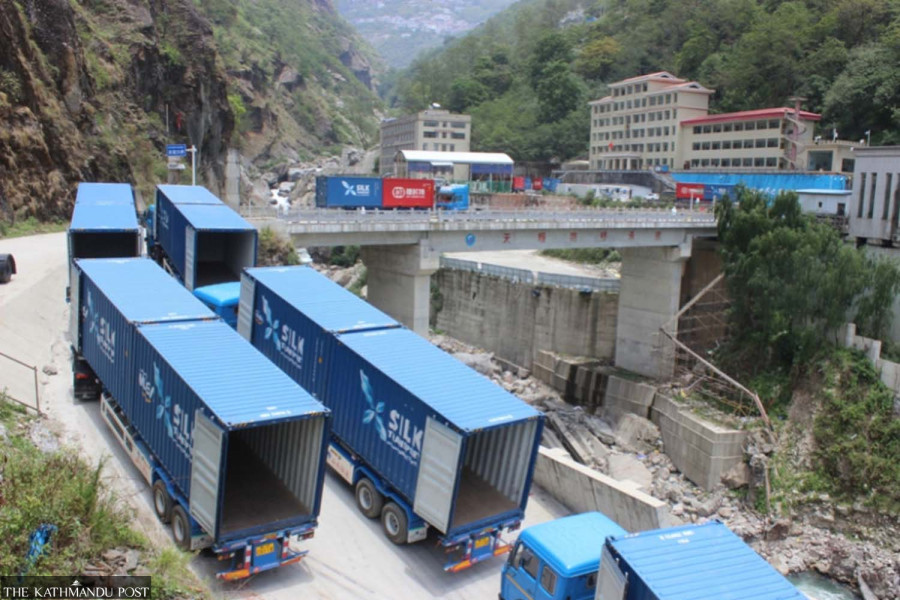Money
Nepal’s trade via northern border resumes after 2 weeks
Traders say cargo containers are in queue in Nyalam, China and may take 8–10 days to arrive in Kathmandu.
Post Report
The cargo container movement from China, which had been halted at Nyalam and Khasa for the past two weeks due to the construction of a tunnel in the region, resumed on Monday.
Dayananda KC, the Tatopani Customs chief who was recently transferred to the Ministry of Finance, said that the cargo shipment was halted for a few days due to the construction of a tunnel in the Nyalam and Khasa regions.
The goods, mainly readymade garments and fruits, were stuck in the Nyalam and Khasa towns for 15 days. The tunnel's construction had worried Nepali traders who had ordered goods for the upcoming festivals.
As Dashain, the biggest festival in Nepal, is nearing, many traders were worried, said trader Kapil Pakhrin.
According to the Tatopani Dry Port and Customs Office, around 100 containers were stuck at the border. Traders, however, fear that clearing the logjam may take many days.
According to the Department of Customs, imports from China increased 34.2 percent to Rs298.77 billion in the last fiscal year, which ended mid-July.
Similarly, exports to China increased 46.6 percent to Rs2.58 billion in the review period.
Nepal’s trade deficit with China remained negative at Rs296.18 billion.
Tribhuvan Dhar Tuladhar, president of the Nepal Trans Himalayan Association, said cargo containers are in the queue and may take 8–10 days to arrive in Kathmandu from Nyalam.
In Nyalam, cargo containers are in queue due to inadequate parking space in Khasa, he said.
Tuladhar said traders prefer bringing goods from the Tatopani side because the shorter distance compared to the Kerung route means less cost. The dry port of the Tatopani customs is well managed, and administrative work is quick and easy.
Daily, 20–30 goods-carrying trucks are entering through the Tatopani border.
However, the road infrastructure is not good on the Nepal side of the Kerung border. Loaded containers are flowing in, except for the times when rain damages the road or landslides obstruct the road.
Daily, 30–40 loaded containers are entering via Kerung.
According to the association, the trucks are mostly carrying readymade garments, apples, garlic, onions, and hydropower equipment.
It costs around 1,000 Chinese Yuan (Rs18,855) daily as the parking charge in Naylam and nearby places.
Traders said that around 23 containers carrying Chinese fruits are stuck in the Nyalam region. “Some fruits have started decaying in the container,” Pakhrin said.
One Chinese container carries goods equal to three Nepali trucks.
With an aim to make Khasa a smart city within three years, 50 percent of the old construction has already been demolished. The Chinese government is rapidly constructing buildings, roads, tunnels, and other infrastructure, according to Nepali traders.
Due to the tunnel construction, as part of the Chinese smart city project, containers were restricted from entering Khasa until Tuesday (September 3) starting on August 30.
KC said that Nepali traders bear the brunt of the disruption in ferrying goods, as it would increase the parking fee, cost of meals, and bank interest. “It will add cost for customers.”
Since March, Kimathanka in Sankhuwasabha and 13 other trans-Himalayan trade points have reopened after four years, but there is no cross-border trade happening from these points.
Chinese authorities closed the border in January 2020 to prevent the spread of the coronavirus. They did not reopen for a long time, hugely affecting the Nepalis living in remote mountain villages near Tibet.
In March last year, China officially opened the Rasuwagadhi-Kerung border point. Two months later, it reopened two-way cargo movement from the Tatopani border, too.
Rasuwagadhi-Kerung and Tatopani-Zhangmu/Khasa are two international trade routes connecting Nepal and China.
Tatopani-Khasa, 115 kilometres from Kathmandu, has historically been the main land route for trade with China.
The Rasuwagadhi-Kerung customs point, 190 kilometres from Kathmandu, was being used as an alternative route after the closure of the Tatopani-Khasa point in 2015.




 6.73°C Kathmandu
6.73°C Kathmandu














